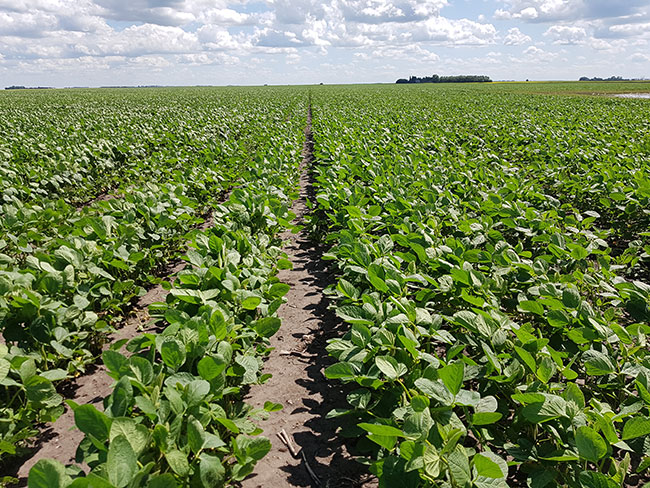
Features
Agronomy
Soybeans
Narrow row soybeans perform well
Three years of Manitoba On-Farm Network research finds narrow row soybeans yield as well as or better than wide rows.
December 21, 2022 By Bruce Barker
 In On-Farm trials, narrow row soybeans have performed as well as or better than wide rows.
In On-Farm trials, narrow row soybeans have performed as well as or better than wide rows. What is the optimum row spacing for soybeans in Manitoba? With the wide range in seeding equipment from narrow row air drills to 30-inch row spacing with planters, the question has been around since soybeans first became popular in Manitoba. Now, research from Manitoba Pulse and Soybean Growers’ On-Farm Network is seeking to provide guidance to farmers.
“Our purpose is to bridge the gap between small plot research and what happens on the farm,” says Leanne Koroscil, On-Farm Network agronomist with Manitoba Pulse and Soybean Growers in Carman. “We realistically try out research in a field-scale situation to produce unbiased results.”
The On-Farm Network research is supervised by Koroscil, with research protocols laid out to ensure randomization and replication. Farmers use their own equipment and management practices. In the case of the soybean row spacing trials, MPSG collects plant stand and canopy closure data and measures yield.
Previously, small plot research by Agriculture and Agri-Food Canada research scientist Ramona Mohr in Brandon, Man., found that narrow rows produced yields equal or greater to wide rows at the 20 site-years from 2011 to 2013. In six of seven site-years where nine- to 10-inch row spacings were compared to 27- to 30-inch spacings, the narrow rows had the greatest and most consistent yield. When compared to 16- to 24-inch row spacings, narrow rows had slightly higher yield in two of 13 site-years, and were similar the rest of the time.
The On-Farm Network trials on soybean row spacing have been running since 2019 to help validate Mohr’s small plot research. From 2019 to 2021, sixteen trials have been conducted comparing either narrow versus intermediate widths of 7.5 inches versus 15 inches, or 10 inches versus 20 inches. Intermediate (15 inches) vs. wide (30 inches) rows were also compared. In 2022, another three trials were conducted in Landmark, Clearwater and Dauphin but those results aren’t available yet.
Overall, in the sixteen trials from 2019 to 2021, there were five cases where row spacing resulted in statistically different yield results. In the other 11 cases, there were no differences in yield.
Narrow rows outyielded intermediate rows in three of seven site-years by an average of 1.8 bushels per acre (bu/ac). Intermediate rows outyielded wide rows at two of nine site-years for an average yield increase of 2.1 bu/ac. These results occurred in 2019 and 2020. There were no differences in 2021, which was a very dry year.
“This year there was a late start to the growing season and it was very wet. That’s in stark contrast to previous years. It will be interesting to see the results from 2022,” Koroscil says.
An area that Koroscil would like to investigate by surveying participating producers is the reason that they are choosing their row spacing. It could be due to available equipment, seeding rate considerations, canopy closure for better weed control, or chasing yield. Or maybe some are using wide rows for inter-row cultivation.
“We want to ask producers why they chose the row spacing they are using. We don’t know the answers right now,” Koroscil says.
Overall, both the small plot research and On-Farm Network trials have found that for producers who only have narrow row air drills, this equipment provides soybean yields just as good or better as wide row planters. For producers using wide row planters, there may be a benefit to moving to narrow row air drills, if it fits their farm management system.